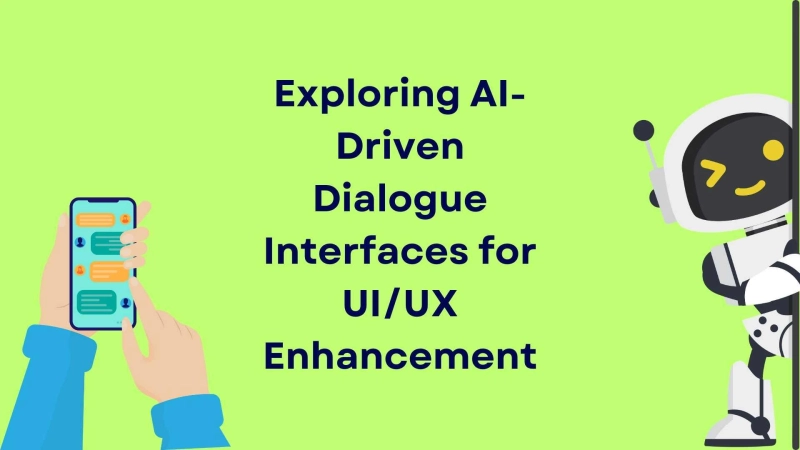In today's rapidly evolving digital landscape, businesses are constantly seeking innovative ways to enhance user experiences (UI/UX) within their applications. Traditionally, UI/UX design services have focused on creating visually appealing interfaces and intuitive navigation systems. However, with the advent of artificial intelligence (AI) technologies, a new paradigm is emerging – one where dialogue interfaces powered by AI are poised to revolutionize the way users interact with business applications.
As businesses continue to embrace digital transformation, the importance of delivering seamless and user-friendly experiences within their applications cannot be overstated. Traditional UI/UX design principles have served as the foundation for creating interfaces that are visually appealing and easy to navigate. However, with the rise of AI technologies, there's a growing opportunity to rethink how users interact with business applications.
Exploring AI-Driven Dialogue Interfaces
AI-driven dialogue interfaces represent a paradigm shift in UI/UX design. Unlike traditional interfaces, which rely on predefined layouts and interactions, dialogue interfaces leverage AI algorithms to understand user intent and provide personalized responses in natural language. This allows for more dynamic and conversational interactions, creating a more engaging user experience.
Benefits of AI-Driven Dialogue Interfaces
Enhanced Personalization
AI-driven dialogue interfaces excel in analyzing vast amounts of user data in real-time. This data includes browsing history, past interactions, preferences, and behavior patterns. By leveraging machine learning algorithms, these interfaces can discern intricate nuances in user preferences and tailor responses and recommendations accordingly. For instance, in an e-commerce application, AI can recommend products based on previous purchases, browsing history, and even demographic information. This level of personalization enhances user satisfaction and increases the likelihood of conversion.
Improved Efficiency
One of the most significant advantages of AI-driven dialogue interfaces is their ability to automate routine tasks and provide instant responses to user inquiries. For businesses, this translates to streamlined workflows and improved productivity. Tasks that once required manual intervention can now be executed automatically, freeing up human resources to focus on more complex and strategic endeavors. Moreover, instant responses to user inquiries contribute to a seamless user experience, reducing waiting times and increasing user engagement.
Natural Language Understanding:
Traditional interfaces often require users to navigate through menus, buttons, and forms to accomplish tasks. However, AI-driven dialogue interfaces operate on a different paradigm. They enable users to interact with applications using natural language, mimicking human-like conversations. This makes the user experience more intuitive and accessible, particularly for individuals who may struggle with traditional interfaces. Whether it's asking a question, issuing a command, or providing feedback, users can communicate with the application in a way that feels natural and effortless.
24/7 Availability:
AI-driven dialogue interfaces are not bound by time zones or office hours. They operate round-the-clock, providing uninterrupted support and assistance to users whenever they need it. This 24/7 availability is particularly valuable in industries such as customer service and technical support, where timely assistance is critical. Users no longer have to wait for business hours to seek help or resolve issues; instead, they can access support instantaneously, leading to greater satisfaction and loyalty.
Data-driven Insights:
Every interaction with an AI-driven dialogue interface generates valuable data points that can be analyzed to extract insights into user behavior and preferences. By examining patterns in user interactions, businesses can gain a deeper understanding of their audience and tailor their products and services accordingly. For example, analysis of user queries and feedback can reveal common pain points or areas for improvement, guiding product development efforts. Similarly, insights into user preferences can inform targeted marketing strategies, leading to more effective campaigns and higher conversion rates.
Challenges and Considerations
While AI-driven dialogue interfaces offer numerous benefits, they also present several challenges and considerations for businesses to address:
Accuracy and Reliability: Ensuring that AI algorithms accurately understand user intent and provide relevant responses is crucial for maintaining user trust and satisfaction.Privacy and Security: Collecting and analyzing user data to personalize interactions raises concerns about privacy and security. Businesses must implement robust data protection measures to safeguard sensitive information.Integration and Compatibility: Integrating AI-driven dialogue interfaces with existing systems and platforms can be complex and time-consuming, requiring careful planning and execution.User Acceptance: Convincing users to embrace AI-driven dialogue interfaces may require education and awareness-building efforts to demonstrate the value and convenience they offer.Future Implications and Trends
As AI technologies continue to advance, the potential applications for AI-driven dialogue interfaces in business applications are limitless. From virtual assistants that assist users with everyday tasks to chatbots that handle customer inquiries, the future of UI/UX design services is undoubtedly AI-driven. Businesses that embrace these technologies early on stand to gain a competitive advantage by delivering superior user experiences and driving customer satisfaction.
Conclusion
In conclusion, the emergence of AI-driven dialogue interfaces represents a transformative shift in the field of UI/UX design services. By leveraging AI algorithms to understand user intent and provide personalized responses, businesses can create more engaging, efficient, and user-friendly experiences within their applications. While challenges and considerations remain, the potential benefits of AI-driven dialogue interfaces are undeniable. As businesses look to stay ahead of the curve in an increasingly digital world, partnering with a UI UX Design Company in Bangalore that specializes in AI-driven solutions may be the key to unlocking new opportunities and driving business success.


